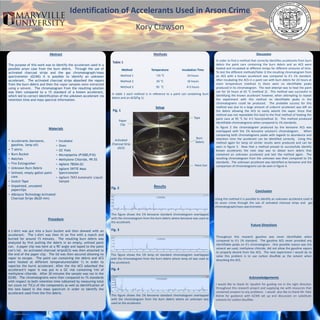More Related Content Similar to ArsonPoster_Final (20) 1. RESEARCH POSTER PRESENTATION DESIGN © 2012
www.PosterPresentations.com
The purpose of this work was to identify the accelerant used in a
possible arson case from the burn debris. Through the use of
activated charcoal strips and the gas chromatograph/mass
spectrometer (GCMS) it is possible to identify an unknown
accelerant. The activated charcoal strips absorbed the vapors
from the burn debris and then the vapor samples were extracted
using a solvent. The chromatogram from the resulting solution
was then compared to a 1% standard of a known accelerant,
which led to correct identification of the unknown accelerant via
retention time and mass spectral information.
Abstract
A t-shirt was put into a burn bucket and then dowsed with an
accelerant. The t-shirt was then lit on fire with a match and
burned for around 15 minutes. The resulting burn debris was
analyzed by first putting the debris in an empty, unlined paint
can. A paper clip was bent at a 90°angle and taped to the paint
can’s lid. An activated charcoal strip(ACS) was then attached to
the end of the paper clip. The lid was then secured allowing no
vapor to escape. The paint can containing the debris and ACS
were heated at different temperatures(table 1) in order to
vaporize the burnt accelerant. After the the ACS adsorbed the
accelerant’s vapor it was put in a GC vial containing 1ml of
methylene chloride. After 30 minutes the sample was ran in the
GCMS. The chromatograms were then compared to 1% standards
with respect to both retention time (obtained by measuring total
ion count (or TIC)) of the components as well as identification of
the ions based in the mass spectrum in order to identify the
accelerant used from the fire debris.
Procedure
• Accelerants (kerosene,
gasoline, lamp oil)
• T-shirts
• Burn Bucket
• Matches
• Fire Extinguisher
• Unknown Burn Debris
• Unlined, empty gallon paint
cans
• Scotch Tape
• Unpainted, uncoated
paperclips
• Albrayco Technology Activated
Charcoal Strips (8x20 mm)
• Incubator
• Oven
• GC Vials
• Micropipette (P1000,P10)
• Methylene Chloride, 99.5%
• Agilent 7820A GC
• Agilent 5977E Mass
Spectrometer
• Agilent 7693 Automatic Liquid
Sample
Materials
Results
Setup
Discussion
In order to find a method that correctly identifies accelerants from burn
debris the paint cans containing the burn debris and an ACS were
heated and incubated at different temps for different amounts of time.
To test the different methods(Table 1) the resulting chromatogram from
an ACS with a known accelerant was compared to it’s 1% standard.
After incubating the ACS in a paint can with burn debris for 24 hours at
room temperature (method 1) there were no identifiable peaks
produced in its chromatogram. The next attempt was to heat the paint
can for 16 hours at 65 °C (method 2). This method was successful in
identifying the known accelerant however, when attempting to repeat
the experiment with this method no identifiable peaks in the
chromatograms could be produced. The probable success for this
method was due to a large amount of unburnt accelerant was left on
the debris allowing the ACS to easily adsorb the vapor. Since that
method was not repeatable this lead to the final method of heating the
paint cans at 95 °C for 4-5 hours(method 3). This method produced
identifiable chromatograms when compared to 1% standards.
In figure 2 the chromatogram produced by the kerosene ACS was
overlapped with the 1% kerosene solution’s chromatogram. When
comparing both chromatograms peaks with regards to abundance and
retention time the accelerant can be identified correctly. Using this
method again for lamp oil similar results were produced and can be
seen in figure 3. Now that a method proved to successfully identify
known accelerants the next step was to obtain burn debris that
contained an unknown accelerant and test the method again. The
resulting chromatogram from the unknown was then compared to 1%
standards. The unknown accelerant was identified as kerosene and the
comparison of chromatograms can be seen in figure 4.
Future Directions
Throughout this research gasoline was never identifiable when
compared to it’s 1% standard. The gasoline ACS never provided any
identifiable peaks on it’s chromatogram. One possible reason was the
solvent we used, methylene chloride, did not allow the gasoline vapors
to properly desorb from the ACS. The next experiment I would do to
solve this problem is to use carbon disulfide as the solvent when
desorbing the ACS.
Acknowledgements
I would like to thank Dr. Spudich for guiding me in the right direction
throughout this research project and supplying me with resources that
contained answers to any problems. I would also like to thank Mr. Pete
Kleine for guidance with GCMS set up and discussion on substitute
solvents for carbon disulfide.
Kory Clawson
Identification of Accelerants Used in Arson Crime
Tape
Paper
Clip
Activated
Charcoal Strip
(ACS)
Burn
Debris
Paint Can
Fig. 2
Fig. 3
Fig. 4
This figure shows the 1% kerosene standard chromatogram overlapped
with the chromatogram from the burn debris where kerosene was used as
the accelerant.
This figure shows the 1% lamp oil standard chromatogram overlapped
with the chromatogram from the burn debris where lamp oil was used as
the accelerant.
This figure shows the 1% kerosene standard chromatogram overlapped
with the chromatogram from the burn debris where an unknown was
used as the accelerant.
Conclusion
Using this method it is possible to identify an unknown accelerant used in
an arson crime through the use of activated charcoal strips and gas
chromatograph/mass spectrometer.
Table 1
Methods
Method Temperature Incubation Time
Method 1 ~25 °C 24 hours
Method 2 65 °C 16 hours
Method 3 95 °C 4-5 hours
In table 1 each method is in reference to a paint can containing burn
debris and an ACS(Fig 1).
Fig. 1
